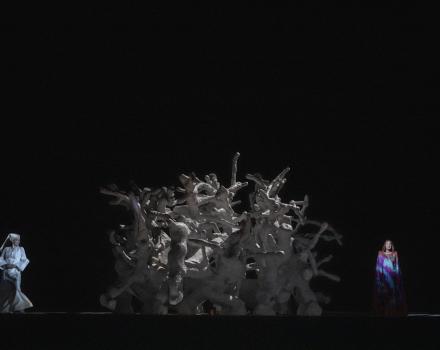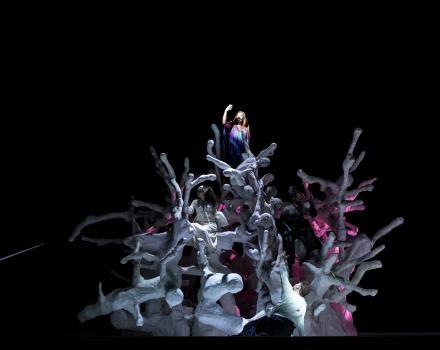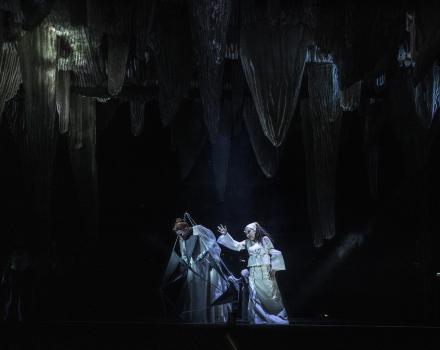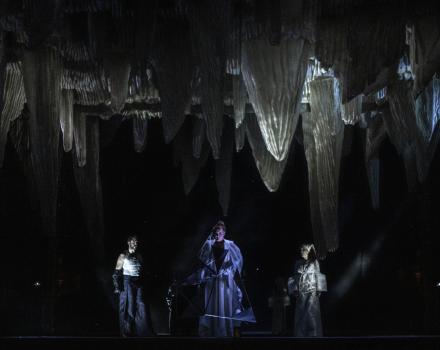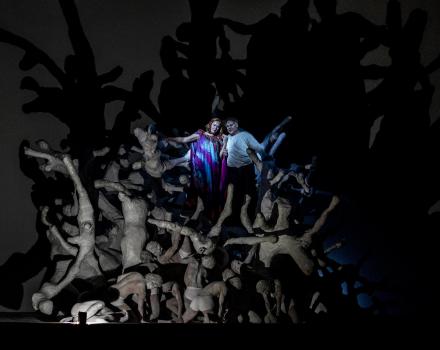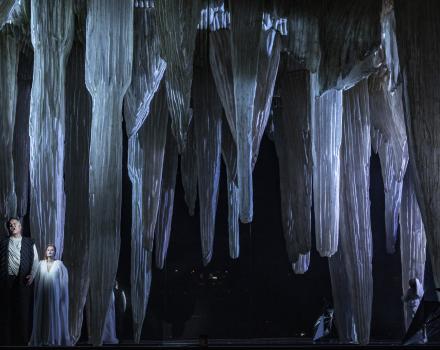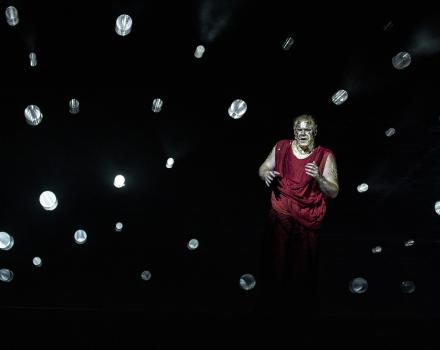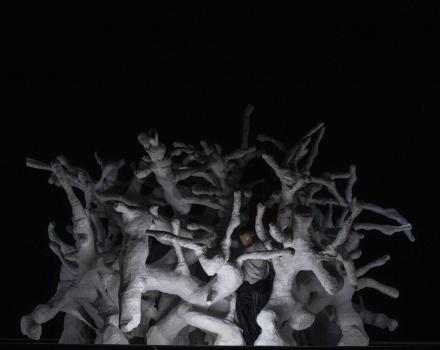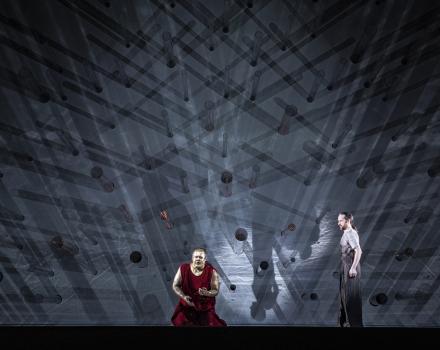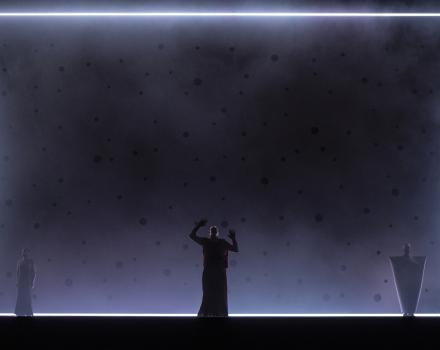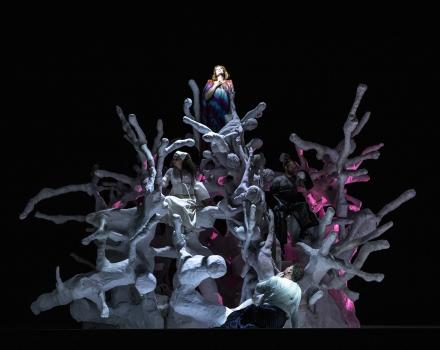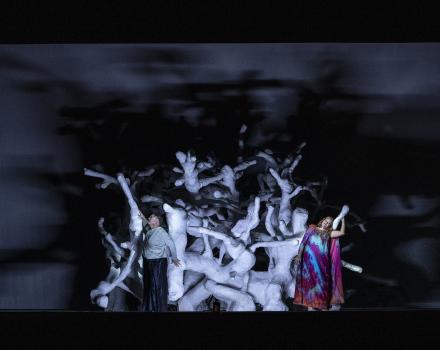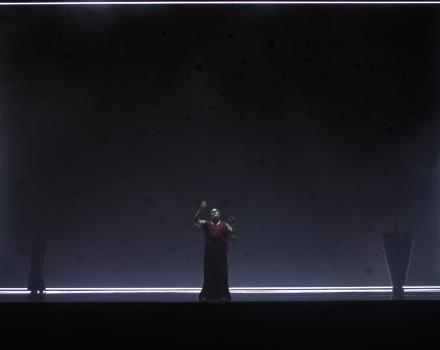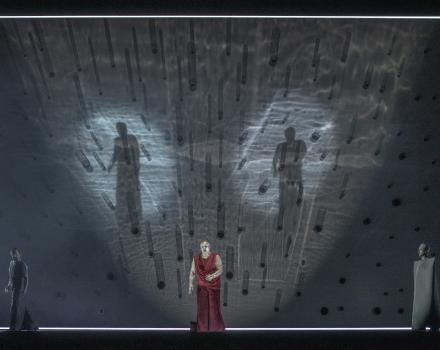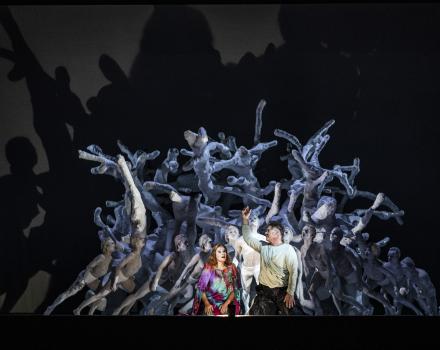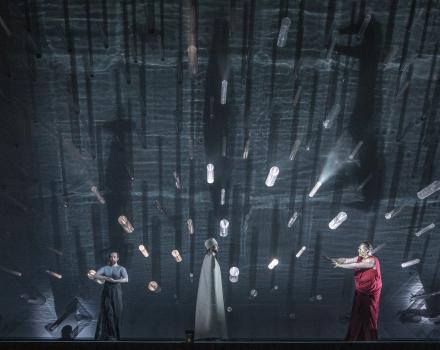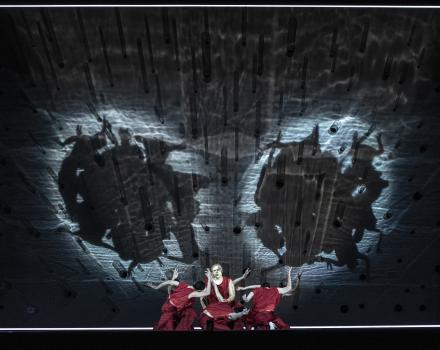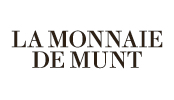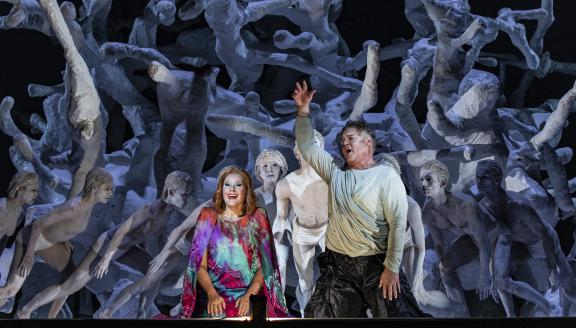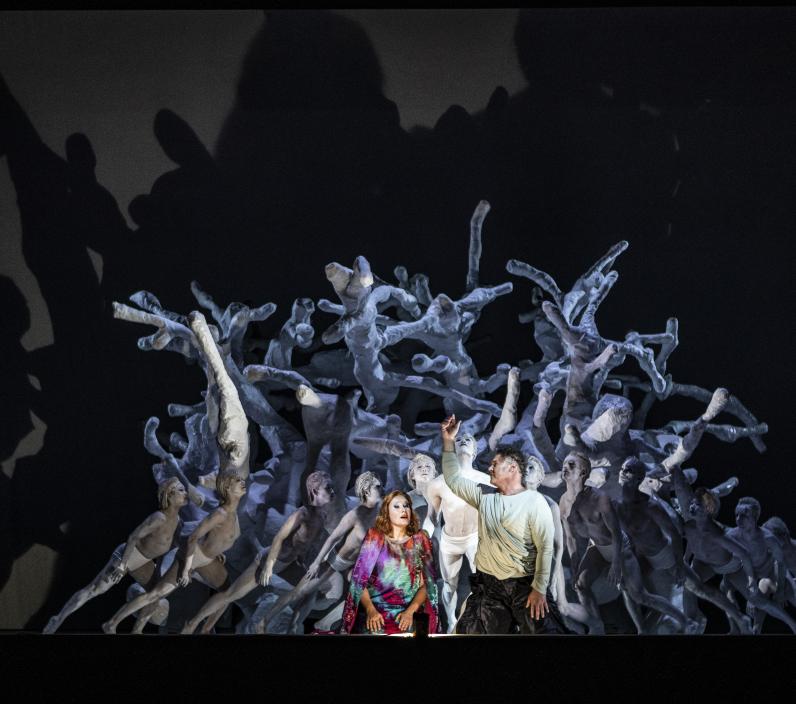

While a knight accompanies a princess to be married off to his master, an unspoken love kindles between them. But when their secret passion is betrayed, they seek refuge for their eternal love in death.
A hymn to the mythic power of love, Wagner’s Tristan & Isolde is a watershed in Western music. Its musical innovations, innovative use of harmony and polyphony and portrayal of extreme emotions have influenced generations of composers.
Cast
Tristan | Bryan Register |
|---|---|
King Marke | Franz-Josef Selig |
Isolde | Ann Petersen |
Kurwenal | Andrew Foster-Williams |
Brangäne | Nora Gubisch |
Melot / A helmsman | Wiard Witholt |
A shepherd / A young sailor | Ed Lyon |
Chorus | La Monnaie's Men Chorus |
Orchestra | La Monnaie's Symphony Orchestra |
| ... | |
Music | Richard Wagner |
|---|---|
Conductor | Alain Altinoglu |
Director | Ralf Pleger |
Sets | Alexander Polzin |
Lighting | John Torres |
Costumes | Wojciech Dziedzic |
Text | Richard Wagner |
Chorus Master | Martino Faggiani |
Artistic concept | Ralf Pleger & Alexander Polzin |
Concertmaster | Saténik Khourdoian |
TV Director | Myriam Hoyer |
| ... | |
Video
The story
Eager to free Cornwall from the tribute it pays to Ireland, King Marke charged his vassal and nephew Tristan to face the Irish knight Morold, who comes every year to collect the tax. During the fight, Tristan manages to kill Morold but is wounded by his opponent's poison-coated sword. Only Isolde, Morold's fiancée and the daughter of the King of Ireland, is able to heal this wound, as she is the sole holder of the antidote. Under the name of Tantris, Tristan, therefore, goes incognito to Ireland. However, Isolde recognizes in Tantris the murderer of her fiancé; but something in her eyes makes her fall in love with him and gives up revenge. She heals Tristan and lets him return to Cornwall. Soon after, Tristan goes back to Ireland to bring back Isolde, who is to marry King Marke?
Act I
At sea, on the deck of Tristan's ship during the crossing from Ireland to Cornwall. Isolde expresses her anger: she is furious at Tristan's betrayal and at having to enter into a political marriage, without love, with Marke. She has Tristan sent for her next daughter Brangäne. But he declines the invitation, supported by his squire Kurwenal, who sings a song that makes fun of Morold. This only exasperates the fury of Isolde, who reveals the truth about Tristan to Brangäne. She sends her confidant to insist that Tristan speak to her before they arrive in Cornwall. Isolde is determined to wash away the insult Tristan has done to her by arousing her love and then come and get her for someone else. She asks Brangäne to prepare a poison which she finds in the box containing the potions made by her mother. When Tristan finally appears, Isolde demands reparation. Tristan offers her his sword to kill him, but she prefers to erase the affront with a ‘reconciliation drink’. In the meantime, Brangäne has discreetly exchanged the poison for a love potion. Both Tristan and Isolde drink the drink and fall into each other's arms. At the same time, the ship docks in Cornwall.
Act II
In King Marke's castle in Cornwall. Marke and his retinue went hunting. It's night, and Isolde is waiting impatiently for Tristan. However, Brangäne has noticed that Melot, one of Marke's courtiers, is keeping a suspicious eye on Tristan and warns Isolde about him. But the young woman doesn't believe what the next one says and asks him to put out the torch so that Tristan knows he can safely join her. In a great duet, Tristan and Isolde celebrate their love: they curse the day and bless the night, the kingdom of true love. There, as an omen of death, all boundaries between the lovers are abolished and the perfect union can be accomplished. Brangäne is on the lookout, but like Tristan and Isolde, she is totally surprised by the irruption of Marke, whom Melot has informed. The night hunt was just an excuse to catch the lovers in the act. Marke is deeply saddened by this betrayal, which he does not understand. Tristan doesn't know what to say to him, except that he now lives in a completely different world than he does. When, in the meantime, he invites Isolde to follow him to the ‘land where the sunlight does not shine’, Melot, seized by jealousy, comes between the young men and Tristan throws himself on the drawn sword of the courtier.
Act III
Kareol, the castle of Tristan in Brittany. In Tristan’s ancestral castle, Kurwenal stands guard over his master, mortally wounded, whom he brought back to Kareol to recover. As Tristan's wound would not heal, the squire again called Isolde for help. She may arrive from Cornwall at any moment. Kurwenal has instructed a young shepherd to watch the sea and signal to him as soon as the young woman's ship is in sight. Tristan, coming out of a half-sleep, believes in his delirium to see Isolde before him and expresses the wish to enter with her into eternal night. When the shepherd announces Isolde's arrival with a joyful melody, Tristan is overjoyed; hearing her voice, he even tears off his bandages. Isolde barely has time to hug him before he passes away. She loses consciousness and collapses on his body. A second ship docks, with Marke, Brangäne and Melot on board. Kurwenal, who doesn't know that Marke has come to bring forgiveness and reunite the lovers, rushes at the newcomers with fury. He kills Melot and then collapses, mortally wounded, next to Tristan's body. Isolde then regains consciousness one last time before following Tristan in the ‘love death’.
Insights
5 things to know about Tristan & Isolde
1° New beginnings
Tristan & Isolde ushered a new beginning for Wagner. Many would argue that it did for the genre of opera as a whole. Composed between 1857 and 1859, in the midst of his work on the Ring, it marked a departure from plot-driven romances towards metaphysical meditations on human existence itself. Friedrich Nietzsche would later call the opera the ‘opus metaphysicum of all art’.
Influenced by the philosophy of Arthur Schopenhauer, whose central work The World as Will and Representation inspired the conception of Tristan & Isolde, Wagner began to see life on earth as dominated by unfulfilled longing. Anecdotally, his own longing for his friend, the author and poet Mathilde Wesendock, whose husband Otto was his benefactor, remained similarly unfulfilled. She is considered as the opera’s other major inspiration.
2° The loveliest of all dreams
In a letter to his future father-in-law Franz Liszt dated 16 December 1854, Wagner wrote: ‘Never in my life having enjoyed the true happiness of love I shall erect a memorial to this loveliest of all dreams in which, from the first to the last, love shall, for once, find utter repletion. I have devised in my mind a Tristan und Isolde, the simplest, yet most full-blooded musical conception imaginable, and with the ‘black flag’ that waves at the end I shall cover myself over – to die.’
Love stories have been at the heart of opera for centuries before Wagner came along. Wagner’s version transcends their conventional scenario, elevating it into a profound philosophical exploration on the metaphysics of subjectivity and the union of souls and the mysteries of the natural world and what lies beyond.
3° Music, the initiator of all passions
Not only has Tristan & Isolde transcended the previously accepted limits of subjects, but its impact on the history of music was also lasting. Many would argue that the prelude’s opening chord, famously known as the Tristan chord, prompted the beginning of modern music as it introduced chromaticism and dissonance. Completely ignoring traditional tonal harmony, the chord refuses to resolve by finishing in another dissonant chord.
What fascinates La Monnaie’s music director Alain Altinoglu most as a conductor is ‘the innovative function of the orchestra in this opera’. He considers that ‘Tristan has the allure of a great symphonic poem, where the orchestra goes beyond the role of mere commentator or accompanist to become the initiator of all passions and their ambivalence. The birth, interaction and transformation of a few simple musical mother cells lead to a cosmic, universal and eternally modern masterpiece.’
4° A dreamlike world on stage
In La Monnaie’s production recorded almost exactly one year ago, on 17 May 2019, two German artists elaborate a common vision. The director Ralf Pleger hails from the word of theatre and film, while set designer Alexander Polzin is mostly known as a sculptor and painter. Jointly, they create a different scenic image for each act, which bears no direct connection to the plot but plunges the viewer into a dreamlike state. Such a visually minimalismist focusses all attention on the music and the libretto.
By erasing any concrete reference to the plot - no cup to be seen, hardly an allusion of a spear - it fades into the background and the passions become even more internalised, transcendent. The love scene in Act 2, for instance, is experienced by a motionless Tristan and Isolde, standing on a curious pile of white branches. When these ‘branches’ slowly start undulating in a sensual choreography, they perfectly mirror the lovers’ heart-rending contradictory emotions.
5° Intoxicating questions
The director Ralf Pleger interprets the love potion that Tristan and Isolde drink in Act 1 as a genuinely hallucinogenic substance opening new dimensions for them. Wagner’s music, which has often been described as intoxicating, clearly echoes how the potion enters the lovers’ bodies and transforms their consciousness. Pleger’s staging imagines the couple’s sensorial experience during this metaphysical trip. Accordingly, the scenic tableaux seem torn right out of a psychedelic dream. In Act 3, for example, a celestial background of lights and shadows is displayed behind the singers, extending their passions into the universe.
In the eyes of the director, the opera raises great questions about our origins and our destination. ‘In their opening of consciousness, are Tristan and Isolde able to see this other, perhaps deeper truth? Does their drunkenness give them this ‘universal clairvoyance’, as Wagner would later formulate it in Parsifal? What happens inside them when, in their great duet, they declare themselves to be the world? And above all, is love the answer?’
Gallery
